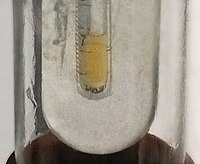
Photo from wikipedia
Salmonids are poikilotherms, which means that their internal temperature varies with that of water. Water temperature thus controls many of their lifecycle processes and physiological functions, which could influence the… Click to show full abstract
Salmonids are poikilotherms, which means that their internal temperature varies with that of water. Water temperature thus controls many of their lifecycle processes and physiological functions, which could influence the mechanisms of absorption, distribution, metabolism and excretion (ADME) of many substances, including perfluorinated alkyl acids (PFAAs). However, the processes governing the fate of PFAAs are still poorly understood in fish. Here we developed a physiologically-based toxicokinetic (PBTK) model for rainbow trout (Oncorhynchus mykiss) to study changes in physiological functions and PFAA ADME at different temperatures. The model was calibrated using experimental data from dietary exposure to perfluorooctane sulfonate at 7 °C and 19 °C. Predictions of PFOS concentrations were globally satisfactory at both temperatures, when accounting for the influence of temperature on growth, ventilation rate, cardiac output, clearances, and absorption rates. Accounting for the influence of temperature on tissue-plasma partition coefficients significantly improved predicted in-organ PFOS concentrations.
Journal Title: Aquatic toxicology
Year Published: 2020
Link to full text (if available)
Share on Social Media: Sign Up to like & get
recommendations!